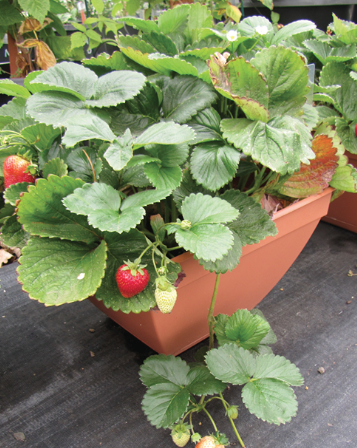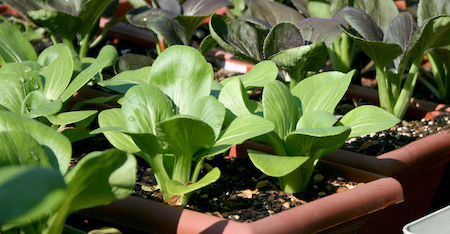Potagers in Pots: Fresh Veggies with Container Gardening
By Janet Scheren, Fairfax Master Gardener Intern
 Carrots in containers
Carrots in containers- You can virtually eliminate most soil-borne diseases by replacing the soil in the pot after each successive crop. Thus, you don’t have to rotate crops each year to avoid disease and pests that can build up in the soil. Just start with fresh soil.
- There’s no digging or tilling required, and it’s easy to keep containers weed free.
- It’s great to have easy-to-snip lettuces, greens and herbs close at hand as well as frequently harvested vegetables from containers.
- Container gardening is inexpensive and allows you to move plants to take advantage of their best sun exposure and avoid extreme weather conditions.
Picking the Right Containers
A wide variety of containers are suitable for growing vegetables — clay, wood, plastic or metal. Just be sure to select containers that are large enough to support the fully grown plants and provide room for watering and adequate drainage. You also need to avoid containers that have been used for toxic substances or that are made of pressure treated wood. If an otherwise suitable container lacks drainage holes, you can drill them. To make plant care even easier, there are many self-watering containers available online or from your local garden center — or you can make one.
While you’re selecting containers, pick up some pot feet. These raise containers off your deck, balcony or patio surfaces, thus promoting drainage and avoiding rot or mold on the surfaces below. Pots can also be placed directly on soil or mulch. One garden expert cuts the bottom out of pots and places them directly on soil to allow maximum drainage and root growth.
Planting Media — Soil
Select a prepared soil that is specifically blended for pots. These potting soils provide a lightweight growing medium with high organic content that holds adequate moisture. You can also use of mix of one part peat moss, one part garden loam/compost, and one part coarse perlite/ builder sand. Don’t use topsoil or standard garden soil in pots. These hold too much moisture and can result in root rot. You also need to avoid sterile, soilless mixes as they contain few nutrients and are devoid of trace minerals. Moisten your potting soil until it is like crumbly brownie mix — not soggy, not dry — before adding seeds or seedlings. Leave an inch or two between the top of the soil and the rim of the container, depending on container size, to avoid water runoff and allow water to soak in. Most vegetables prefer more neutral soil but can be grown in soils with a pH between 5.5 to 7.0.

Strawberries in containers on a deck
Check your pots daily, especially smaller pots, as containers can dry out quickly, particularly in full sun. You may need to water twice if there’s extreme heat or windy weather. Pots with foliage shading the soil will dry out more slowly. Stick your finger in the pot to check before watering. If the soil is already moist or wet, don’t water. This can result in root rot. If the soil feels dry, water thoroughly.
Location/ Sun Exposure
The number of hours of sun exposure each day will determine which vegetables you can successfully grow. Southern and western exposure are hotter and drier. Eastern exposure provides morning sun and the relief from hot afternoon that many veggies prefer.
With four to six hours of direct sun a day, you can grow a good crop of greens, including lettuce, cilantro, parsley, arugula, spinach, kale and cabbage. Six to eight hours of sun opens your options to root vegetables (e.g., carrots and beets), flower vegetables (e.g., broccoli and cauliflower), and fruiting vegetables (e.g., tomatoes and peppers). Most herbs are of Mediterranean origin and require full sun and drier soils.
Keep in mind that sun exposure can vary depending on the time of year. A location that has only partial sun during the summer may provide full sun once the leaves are off the trees. This expands your options for cool weather crops in the spring and fall.

Lettuce in container
The Virginia Cooperative Extension fact sheet on “Vegetable Gardening in Containers” lists the minimum container sizes needed to grow vegetables. It notes you can grow beets, carrots, swiss chard, leaf lettuce, green onions and radishes in smaller half gallon containers. Stepping up to medium containers of 1 to 3 gallons adds bush beans, bell peppers and turnips to the mix. Using a 5-gallon container or larger allows you to include cabbage, cucumbers, eggplant, kale, summer squash and smaller or cherry tomatoes. These are minimums, so you can always use a larger container. Rounding out your potager in pots, potatoes and peas can also be successfully grown in containers. Also look for dwarf or compact vegetable varieties, making them even easier to grow in containers. These may be labeled patio plants.
Check for pests regularly. Vegetables generally attract more bugs than flowers. Fertilize with a slow-release fertilizer when you plant. The veggie/flower combos need more feeding than regular containers.
Mix it Up — Combinations & Companion Plants
Have some fun with your vegetable container garden. While many greens and vegetables are beautiful plants in their own right, you can enhance the appearance of your containers and attract pollinators needed for fruiting vegetables with the addition of flowers or herbs. Choosing a larger pot, such as a 10- to 20-gallon container, allows more flexibility. Zinnias, marigolds and nasturtiums are a few of the best flowers to add.

Bok Choi in containers
When combining several different plants in one container, be sure to match plants that have a similar need for sun, water and fertilizer. Don’t combine herbs native to the hot and dry Mediterranean climate with vegetables that require frequent watering, such as tomatoes or cucumbers. To maximize space, you might want to combine a trailing plant with an upright plant.
Companion plants can enhance the productivity of your container. Other combinations should be avoided. Here are some good companion plants and combinations to avoid:
Companion Plants
Bush beans with carrots, cucumbers, cauliflower and strawberries
Pole beans with cucumbers and corn
Lettuce with strawberries, carrots, cucumbers and radishes
Tomatoes with basil, onions, parsley and carrots
Spinach with strawberries
Combinations To Avoid:
Beans with onions and garlic
Carrots with dill or fennel
Tomatoes or squash with potatoes
Onions with beans and peas
Keep it Coming!
Think about succession planting for maximum production. Start with lettuces in spring, followed by summer beans and a fall crop of broccoli, then winter greens.
References
Planting a Garden in a Pandemic, Virginia Cooperative Extension
Vegetable Gardening in Containers, Publication 426-336, Virginia Cooperative Extension
Container Vegetable Gardening: Healthy Harvests from Small Spaces, University of Maryland Extension
Carrots Love Tomatoes, Secrets of Companion Planting for Successful Gardening, by Louise Riotte